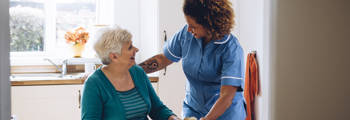18/05/2021
The Joint Committee on Human Rights has renewed its calls for legislation to require care homes to undertake individual risk assessments for each resident in order for family visits to take place. The Committee, along with its report, produced draft legislation for the Government to put before Parliament as soon as possible. Care Minister, Helen Whately, has so far responded that the Government will pursue ‘non-legislative routes’ where a care home’s visiting arrangements are more restrictive than set out in the Government guidance.
Government to ease lockdown restrictions
The call by the Human Rights committee for less restrictive visiting arrangements was made before the Government announced a further easing of national restrictions as part of its route map out of lockdown. The Government announced on 10 May 2021 that care home residents should have the following:
- Up to 5 named visitors (including their essential care giver if they have one) with a maximum of 2 visitors at any one time.
- Visits out of care homes to be permitted in certain circumstances, without the need for self-isolation on return.
- Visits will only pause for a minimum of 14 days rather than 28 days following an outbreak.
Human Rights Committee Conclusions and Recommendations
The Parliamentary Committee looked at visiting restrictions in care homes in England, and it made the following conclusions and recommendations.
- The Government should make the requirement for care home providers to undertake individualised risk assessments for each resident law and ensure that procedures are in place so that these assessments can be queried when they are inadequate.
- Government and care home providers have had a difficult job balancing the right to a family life with the need to protect the right to life of all residents and staff, however many providers have erred too far on the side of caution, to the detriment of residents and their families.
- Government’s guidance has not adequately acknowledged the importance of families to residents’ wellbeing, in particular close family members who provide care, Family care givers could have supported over-stretched care home staff during the crisis.
- The Department for Health and Social Care did not consult widely enough in preparing its guidance, and did not provide sufficient notice when bringing in new changes.
- The Committee criticised the 14-day isolation rule following external visits, suggesting that it was an unlawful interference with an individual’s right to liberty and family life. (Since the publication of the report, the Government has now changed its guidance so that certain external visits are now permitted without the need for isolation on return.)
- Government guidance should not be second-guessed or selectively applied by care home providers.
- There needs to be clarity as to whether national guidance should take priority over local guidance from directors of public health.
- CQC urgently needs to establish better processes for collecting data and monitoring the right of care home residents to receive visitors.
- The Government and CQC must implement a new process for residents to raise valid concerns about care home providers, which guarantees anonymity, and can be used without fear of retaliation.
Evolving Government Guidance
The Government’s approach in its guidance to visiting arrangements in care homes started very cautiously, at first with advice for family and friends not to visit care homes except in exceptional situations.
However, as the pandemic continues, the Government’s language has changed. In November 2020 the approach was to “maintain some opportunities for visiting to take place, critical for supporting the health and wellbeing or residents and their relationships with friends and families”.
More recently, the Government has expressed an aim that by summer, care home visiting will feel as relaxed and normal as possible – retaining only those infection prevention and control measures needed to protect the most vulnerable residents from the risk of infection.
Within its guidance, the Government has consistently deferred ultimate decision making on visiting arrangements to care home providers, in consultation with local directors of public health and directors of adult social services. As the current guidance suggests:
Each care home is unique in its physical environment and facilities, and the needs and wishes of their residents. As such, care home managers are best placed to develop policies (in consultation with residents and their relatives) to ensure that visits described in this guidance are provided in the best way for individual residents, their loved ones, and care home staff.
Comment
It is understandable that at the start of the pandemic the focus was on the preservation of life above all other human rights. The longer the pandemic has continued the more the focus has shifted towards the need for protecting wellbeing.
The Committee’s conclusion that many care home providers had erred too far on the side of caution, to the significant detriment of residents and their families will be difficult for providers to digest. This oversimplifies the exceptional pressures and responsibilities that care homes were under during the pandemic, and when guidance, that was far from straightforward to follow, ultimately deferred the decisions to them.
From a practical perspective, care home providers have had to weigh up a significant numbers of issues such as:
- grappling with a dynamic and complex risk matrix;
- the need to take into account individualised assessments for each resident;
- the evolving circumstances of that resident and their family:
- the needs of other residents,
- the availability of care home staff to work during the pandemic, due to shielding and staff having the virus themselves
- the risk to staff,
- the ever- changing national guidance,
- data on local infection rates from directors of public health and the decisions made by those directors around visiting
- the evolving legal framework.
Given that large list, it is perhaps unsurprising that, when faced with balancing the risk of premature death of a resident against a challenge to over-restrictive visiting arrangements, some care home providers are now being called out for taking an overly cautious approach.
Whilst the Committee is right to report the potential infringements to the right for private and family life, the majority of care home providers must also be recognised for their tireless work in delivering a 24/7 care service during a time of national crisis, prioritising the protection of their residents at all times.
Data Collection
The Committee concluded that there needed to be urgent improvement in the collation of national data on care home visiting. The Committee was particularly critical of the Care Quality Commission (CQC) for not having a sufficient grasp of the data and systems for monitoring adherence on visiting.
Given the criticism by the Committee of CQC and its monitoring of visiting during the pandemic, the care sector should expect a greater emphasis from the regulator on visiting moving forward. It will be interesting to see if the regulator starts to criticise providers for their visiting policies during the pandemic and whether such criticisms arise in inspection reports– an issue no doubt that providers will want to push back on during the factual accuracy process.
What should care homes be doing?
Whilst there is no indication from the Government that the requirement for individualised risk assessments for visiting will become law, the current Government guidance still requires individualised risk assessments to be completed for residents where necessary. There is an expectation by the regulator that care home providers will comply with Government guidance. Care providers should anticipate that CQC will be seeking assurances from them as to how they are supporting visiting to happen and there is a mandatory question on visiting during inspections.
Where a care home provider is uncertain about how to comply with the guidance, in relation to specific circumstances, it should open a dialogue with the director of public health and the regulator.
By being open, transparent and communicative, a care home may be able to reduce the likelihood of complaint, criticism or challenge.
Care home providers will also need to keep their arrangements under review, and document their decision-making clearly.
We can help
At Bevan Brittan we have specialist lawyers who can help care sector providers with advice on litigation, regulatory, commercial and human rights aspects of their work. We can provide training and support to clients around CQC inspections and reporting, Coronavirus regulations, the Equality Act and Mental Capacity and Human Rights law. We can provide practical support to your organisation with any of the points discussed in this article. For more information on how we can help you, please feel free to get in contact with one of our team.



